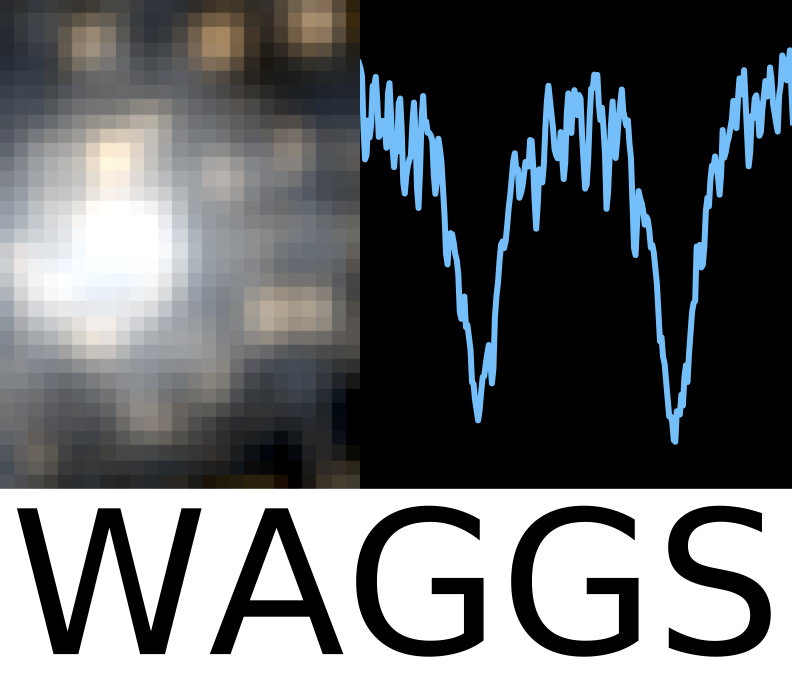
|
WAGGSWiFeS Atlas of Galactic Globular cluster Spectra |
Find information, examples, FAQs and extensive descriptions of the data, curated by the survey teams.

|
WAGGSWiFeS Atlas of Galactic Globular cluster Spectra |
Total Data Releases
1
Total Categories
0
Total Articles
0
Authors
7
The WiFeS Atlas of Galactic Globular cluster Spectra (WAGGS) is a project to obtain integral field spectroscopy of globular clusters in the Milky Way and its satellite galaxies. Details of the survey are presented in Usher et al. (2017). We note that we adopt a definition of globular clusters as any massive, gravitationally bound stellar clusters and as such we include a number of star clusters in the Large and Small Magellanic Clouds that are significantly younger than classical globular clusters.
Measuring the metallicity, age, chemical abundance and initial mass function of integrated galaxy light requires the use of stellar population synthesis models. Before these models can be used, they need to be tested with integrated field spectra of stellar populations with known properties. Globular clusters in Milky Way and its satellites provide such a population as their stellar populations are relatively simple and well understood, with ages and present day mass functions available from HST photometry while metallicities and abundances are available from high resolution spectra of individual stars.
Due to their high surface brightness, globular clusters can be used to study how galaxies form and evolve at much greater distances than individual stars. With integrated spectra of globular clusters in Milky Way and its satellite galaxies, spectra of extragalactic globular clusters can be compared with globular clusters with known properties in a model independent manner.
Integral field spectroscopy of globular clusters also allows for the globular clusters to be studied themselves. Metallicities, ages and chemical abundances can all be measured from the integrated spectra. The spatial resolved kinematics can be used to model the dynamics of globular clusters and measure mass-to-light ratios.
Using the techniques of Kamann et al. (2013) we are able to extract the spectra of individual stars from our datacubes. This allows us to measure the kinematics and chemistries of individual stars and to compare the resolved star results with those from integrate light over the same field-of-view.
The present WAGGS sample includes 93 globular clusters in the Milky Way, 20 in the Large Magellanic Cloud, 8 in the Small Magellanic Cloud and 3 in the Fornax dwarf spheroidal. Our sample is the largest yet of integrated light spectroscopy of Milky Way globular clusters.
The sample spans a wide range of metallicities - from [Fe/H] = −2.4 to [Fe/H] = −0.1 and a wide range of ages - from 20 Myr to 13 Gyr. We also cover a wide range of galactocentric distances and globular cluster masses.
The project prioritised star clusters which have both high quality HST photometry and high resolution spectroscopy of multiple member stars. However, a third of our sample lacks published abundances from high resolution spectroscopy.
We used the Wide Field Spectrograph (WiFeS) on the ANU 2.3 m telescope on 33 nights from January 2015 to September 2018. WiFeS is a dual arm integral field spectrograph with a field-of-view of 38 by 25 arcsec. We used two grating set-ups to cover the wavelength range of 3300 to 9000 Å at a resolution of Δ R / R = 6800. Our wavelength coverage and spectral resolution greatly exceeds previous studies.
The first data release of WAGGS is described in Usher et al. (2017) and consists of 367 integrated spectra of 86 globular clusters in the Milky Way and its satellite galaxies observed with WiFeS. In almost all cases spectra observed with the U7000 (3270 to 4350 Å), B7000 (4170 to 5540 Å), R7000 (5280 to 7020 Å) and I7000 (6800 to 9050 Å) gratings are available. For 9 of the globular clusters repeat observations in at least some of the observations are available. Each of the spectra FITS files contains two extensions. The first provides the flux normalised such the mean flux in the 5300 to 5500 Å wavelength range (the overlap between the B7000 and R7000 gratings) is unity. The second extension provided the uncertainties on the first extension calculated by the PyWiFeS pipeline used to reduce the data.
The spectra can be downloaded here.
WAGGS is a integral field spectrography survey of globular clusters in the Milky Way, the Large Magellanic Cloud, the Small Magellanic Cloud and Fornax dwarf spheroidal galaxy carried out using the WiFeS instrument on the ANU 2.3 m telescope. The survey spans a wide range of ages (from 20 Myr to 13.5 Gyr), metallicities (−2.37 < [Fe/H] < −0.11) and chemistries (−0.05 < [Ca/Fe] < +0.45). Details of the project are presented in Usher et al. (2017).
| http://www.astro.ljmu.ac.uk/~astcushe/waggs/ | |
| Christopher Usher | |
| [javascript protected email address] | |
| - | |
| Jan. 30, 2015 | |
| Completed |